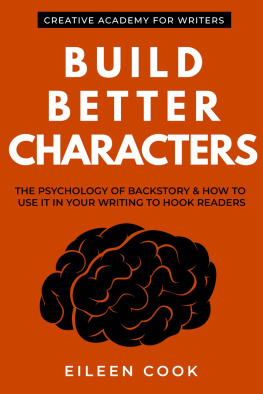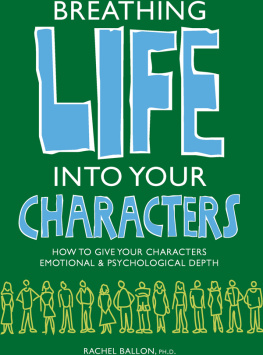

Sign up for our newsletter to hear
about new and upcoming releases.
www.ylva-publishing.com
Table of Contents
Books in the
Writers Guide Series
Goal Setting for Writers
How to set and achieve your writing goals, write a book, and become a successful author
Time Management for Writers
How to write faster, find the time to write your book, and be a more prolific writer
Show, Dont Tell
How to write vivid descriptions, handle backstory, and describe your characters emotions
Point of View
How to use the different POV types, avoid head-hopping, and choose the best point of view for your book

1. Introduction
What this book will teach you
Show, dont tell is probably the single piece of writing advice that beginning writers hear most often from editors and writing coaches. Authors who master this important technique take their writing to the next level and captivate their readers with powerful scenes that keep them turning pages even though its two in the morning and they have to work the next day.
But many writers struggle to understand this principle or have difficulty applying it to their own work. Even authors who have already published several books often dont grasp the finer nuances of showing vs. telling .
I know because I was one of them. When I had a few books under my belt, I thought I knew what showing meant. But then I realized that I had only just scratched the surface. With every novel I wrote and every book about writing I read, I deepened my understanding and discovered more layers to show, dont tell . As an editor and a mentor, I try to teach my writers what I learned about showing and telling . Since there are only so many writers I can mentor and only so many manuscripts I can edit, I decided to write a book about show, dont tell so I can help more writers of all skill levels understand this powerful principle and apply it to their work.
Whether youre a novice writer working on your first story or an established author who has already learned the basics of showing and telling , this book will help you to:
- grasp the difference between showing and telling ;
- understand why showing is such a powerful tool;
- spot telling in your own manuscript;
- fix bland passages and turn them into compelling scenes;
- keep from telling what you have already shown;
- avoid the three danger areas of telling;
- describe your characters and your setting in interesting ways;
- put powerful emotions into your writing;
- incorporate backstory into your novel without resorting to telling ;
- recognize telling in dialogue;
- avoid overshowing and swamping your readers with too many details;
- learn when telling is actually a good thing;
- immerse your readers into your story and keep them captivated from beginning to end.
HOW TO GET THE MOST OUT OF THIS BOOK
The only way to improve your writing is by writing, so this book includes not only concrete examples but also exercises so you can practice what youre learningusing your own work in progress, if you want.
I suggest that you print out the first chapter of your manuscript. Get a notebook or several sheets of paper and a pen and some highlighters. While youre reading this book, stop after every chapter and do the exercises. Most of them will have you work on your manuscript, so by the time you finish this book, youll have a first chapter that is full of good writing that shows instead of tells. Then you can use the techniques you learned on the rest of your manuscript too.
If you dont yet want to practice on your own manuscriptor you dont have a completed first draft yetthere are also twenty exercises in chapter 13 that will help you practice your showing skills.
By the way, a few of the examples I use throughout this book are from my own novels, written under my pen name, Jae (jae-fiction.com ). I do that strictly for legal reasons, to make sure Im not violating anyones copyright. A few of the examples are based on manuscripts I edited, rewritten to protect the innocent.
Happy reading and writing!
Sandra Gerth
2. Definition
What show, dont tell means
At some point in their writing career, all writers get the advice to show , not tell .
Show us that shes a spoiled little girl; dont tell us!
Show us that he lives in a run-down apartment building; dont tell us!
Show us that shes angry at her father; dont tell us!
While thats certainly good advice, many writing coaches, instructors, and editors fail to explain what it means.
So, lets start by defining showing and telling.
Telling means that youthe authorgive your readers conclusions and interpretations; you tell them what to think instead of letting them think for themselves.
Showing means that you provide your readers with enough concrete, vivid details so that they can draw their own conclusions.
Telling is like giving readers a secondhand report afterward.
Showing lets readers experience the events firsthand, through the five senses of the character.
Telling is like reading about an accident in the newspaper the day after it happened.
Showing is like witnessing the accident the moment it happens, hearing the screech of the metal and the screams of the injured.
Telling summarizes events that happened in the past or gives general statements that dont happen at any specific time.
Showing lets readers witness events in real time, in actual scenes with action and dialogue. We stay in the present, firmly rooted in the POV characters experience.
Telling is abstract.
Showing creates a concrete, specific picture in the readers mind.
Telling gives you facts.
Showing evokes emotions.
Telling is also called narrative summary.
Showing is dramatization.
Telling distances readers from the events in the story and from the characters and makes them passive recipients of information.
Showing involves readers in the story and makes them active participants.
AN EXAMPLE
Okay, now that Ive told you what the difference is, let me show you by giving you an example:
Tina was angry.
This is telling. The author is handing readers a conclusion.
Tina slammed the door shut and stormed into the kitchen. What the hell were you thinking?
This is showing. It gives the readers the concrete actions and the characters dialogue so that they can come to the conclusion that Tina is angry without the author stating it flat-out.
EXERCISE #1:
- Get out a notebook or a sheet of paper and try your hand at the Tina was angry sentence. How would you show your readers that Tina is angry without stating her emotions? Use actions, body language, and dialogue to show her anger.
3. The importance of showing
Why showing is usually better than telling
Telling isnt always bad. As well see in a later chapter, it definitely has its uses, but most of the time, you want to show.
Why?
Think about why we read novels. Unlike readers of nonfiction, fiction readers dont read to get information. They read to be entertained and to escape into another world.
Next page












